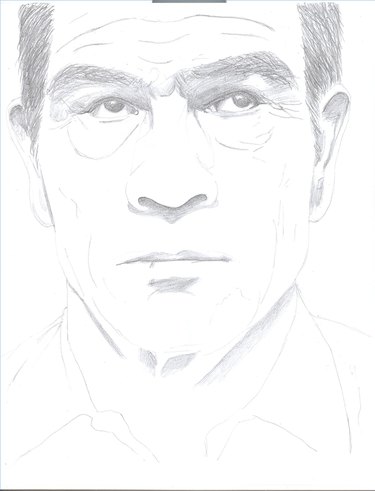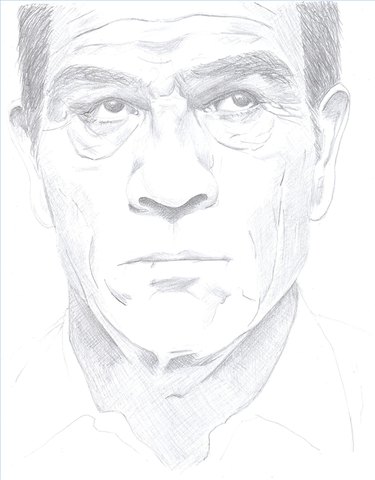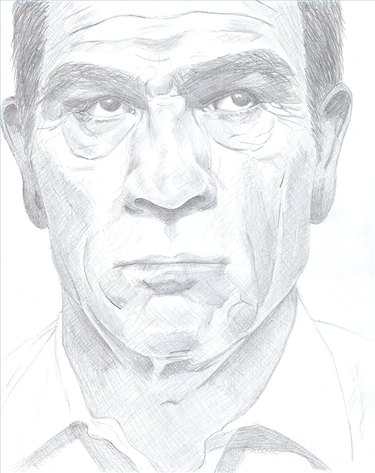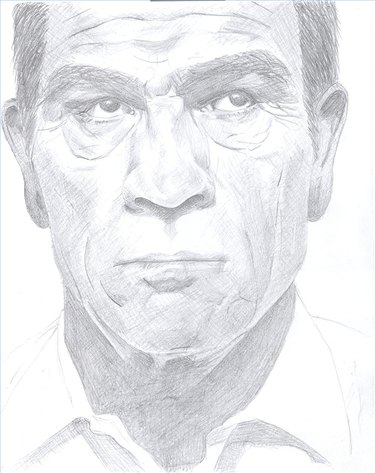Drawing wrinkles on a human face isn't simply a matter of drawing lines. Instead, as with any other form of drawing, you must learn to recognize and draw areas of light and shadow. Many lines will appear as a line; however, it's still important to learn to determine what type of line you're dealing with. It is a thick line? Fine line? A line in shadow or a line in light? Is the line stark and solid, or surrounded by a mound of flesh? When you learn to make these determinations, your ability to draw wrinkles on human faces will be strong.
Step 1
Set up your picture to get the basic outline. You want to try to reproduce the absolute outside of the shape of the face, the eyes, the nose, the mouth, the hair, the ears, and the most prominent wrinkles with accuracy. If necessary, use an art projector or light box to do your initial set-up. This will increase the accuracy of your drawing and decrease errors and the amount of time it takes to complete your drawing.
Video of the Day
Step 2

Fill in the darkest areas of the drawing, starting with the eyes. After all, the eyes are the windows of the soul. Getting the eyes done first will help you to stay in touch with the personality of your subject, and will increase the likelihood that you will reproduce him faithfully. It's usually best to do the nose and lips before you do peripheral elements such as hair, ears and clothing. Begin to fill in the darkest and thickest lines, which represent the wrinkles, on your subject's face. As mentioned above, examine the lines on your subject and determine their quality. Don't bear down too hard for dark or thick lines. Instead, work your line several times until it attains the quality you see on your subject. When filling in areas of shadow, use a cross hatch line. First make cross hatch lines going diagonally in both directions. Then make cross hatch lines going from side to side and up and down. Don't use any smoothing techniques on this drawing, as the cross-hatch lines will help to contribute to the appearance of craggy, heavily lined and sagging skin, and will give your final drawing more texture.
Step 3

Fill in the mid tones. You're looking for the parts of the face that are in shadow. These can be difficult to find when you're new to art. You must learn to see in order to tell the darkest parts of the face from the lightest parts. Examine your subject's wrinkles carefully. Where do you see gradual shading? Where do you see areas of highlight? Look at each area relative to the other areas near it. One area may be in shadow, for example, but is still very light in relation to the skin directly below. It's important to get these relative values right. Once you begin to fill in the shadow faithfully according to what you see, your drawing will come to life. Use the same cross hatching method stated above, but use a much lighter touch. Go back and cross hatch again if you need to darken an area, rather than increasing the pressure on your pencil.
Step 4

Fill in the lightest areas and the details. Use a very light touch with your pencil. Look carefully at your subject, as these are the shadows which are hardest to see and to distinguish from the rest of the subject. Fill in the fine gradation of shading around the wrinkles and, if any highlights near the wrinkles seem too light, go over them with a very light touch. Add in any fine wrinkles you may have missed when you set up your picture. Look for areas of shadow that are between the wrinkles, because these are essential for making your subject look realistic. This will give a sense of the contour and texture of the subject's skin, and can also be important for representing the subject's emotion and thought.
Step 5

Put the finishing touches on your drawing. Check it against your model to see if there are any areas which look too light or too dark, and correct them. Finish your portrait with a spray fixative to protect it.
Tip
Use a black and white photo as your subject, or convert a photo to black and white before using it for your drawing project. Enhance areas of contrast in your drawing to highlight the contours of your subject's face. Don't attempt to draw every single wrinkle on your subject's face. Instead, just try to give the viewer an impression of the most important elements and contours of your subject. Leave areas of blank paper for your highlight. You can also use an eraser to help create highlights on the peaks of skin near wrinkles and folds.
Video of the Day